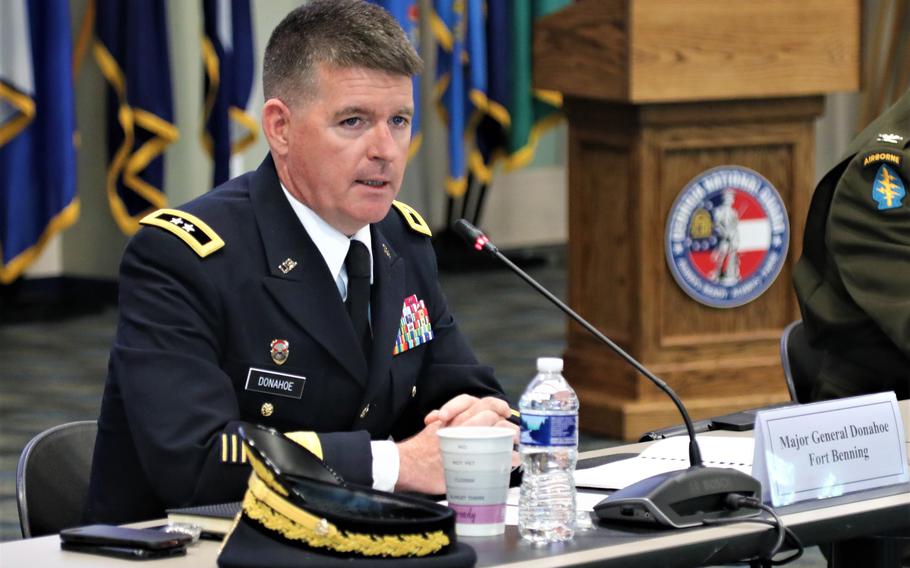
Marine One carrying President Donald Trump and first lady Melania Trump departs the White House Oct. 22, 2020, en route to Joint Base Andrews, Md. The Trump campaign has disavowed the Heritage Foundation’s Project 2025, which includes recommendations for changes to the U.S. military, following attacks by Democrats. But many of Trump’s former appointees crafted the project and several of the proposals are in line with policies Trump has supported. (Tia Dufour/White House)
Banning transgender recruits, abolishing diversity initiatives and shutting down command social media channels are among the changes to the Defense Department being advocated by influential conservatives should Donald Trump return to the White House.
With the presidential election less than three months away, a prominent conservative think tank’s recommendations for the Pentagon and the rest of the federal government remain under examination, even as the Trump camp tries to distance itself from the policy study.
The Heritage Foundation’s 918-page Project 2025 playbook aims to set the agenda for a second Trump term with a program focused on dismantling the “administrative state,” resetting how the government’s major institutions function and pursuing a strict anti-abortion agenda.
In recent weeks, the Heritage project has become a focal point among Democrats for launching attacks on the Trump campaign.
In response, Trump has sought to disavow Project 2025, calling some of the ideas “absolutely ridiculous and abysmal” and claiming he didn’t know who was behind it, despite its authors having significant roles in his administration.
On July 30, the Trump campaign repudiated the project and delivered a warning to those involved in the initiative.
“Reports of Project 2025’s demise would be greatly welcomed and should serve as notice to anyone or any group trying to misrepresent their influence with President Trump and his campaign — it will not end well for you,” the campaign said in a statement.
Project 2025 director Paul Dans, the Trump administration’s chief of staff at the Office of Personnel Management, resigned afterward.
However, the campaign’s disavowal may have had more to do with the right-wing project’s sweeping nature, at a time when presidential campaigns typically move closer to the center and aim to deliver messages with broad appeal.
In 2022, Trump praised the Heritage Foundation for efforts to lay the groundwork “and detail plans for exactly what our movement will do,” according to a video clip from an event hosted by the think tank.
Running mate Sen. JD Vance also has praised Project 2025’s goals. What it envisions for the military lines up with many ideas Trump himself has espoused.

Sen. JD Vance, the vice presidential running mate of former President Donald Trump, visits the 121st Air Refueling Wing May 25, 2023, at Rickenbacker Air National Guard Base, Ohio. Vance in the past has praised the goals outlined in the Heritage Foundation’s Project 2025, which includes removing what conservatives see as “woke” influences from the armed forces. (Ralph Branson/U.S. Air National Guard)
The project’s section dealing with the Defense Department, which entails 127 pages of critiques and recommendations, zero in on many of the culture-war issues that split along partisan lines.
Project 2025’s central theme is the military, historically one of the most trusted institutions in America, has become politicized.
“The DOD is also a deeply troubled institution,” wrote Christopher Miller, who served for a few months as Trump’s defense secretary, in Project 2025’s military section.
The policy playbook says the top priority is to reestablish “a culture of command accountability, non-politicization, and warfighting focus.”
That entails reversing policies that allow transgender people to serve in the military, a position Trump staked out in his first term.
“Gender dysphoria is incompatible with the demands of military service,” the policy plan argues.
The DOD’s policy of facilitating abortion services for troops living in areas where such services are outlawed by reimbursing them for travel costs should be ended, the policy states.
Project 2025 also envisions a near total shutdown on social media channels for military commands.
“Restrict the use of social media solely for purposes of recruitment and discipline any armed services personnel who use an official command channel to engage with civilian critics on social media,” the policy states.
It’s unclear whether Trump supports the idea. The restrictions on social media use could be connected to various dustups that have involved military leaders, who in some cases have taken on their critics.
For example, now-retired Army Maj. Gen. Patrick Donahoe came under criticism in 2021 when he defended female soldiers on Twitter following a segment by former Fox News host Tucker Carlson, who described the U.S. military as becoming “more feminine” while China’s becomes “more masculine.”

Retired Army Maj. Gen. Patrick Donahoe, pictured in a 2021 file photo at Clay National Guard Center in Marietta, Ga., was once criticized for engaging in a social media debate defending female soldiers. The conservative policy document Project 2025 advocates ending the military's official use of social media in most cases. (Bryant Wine/U.S. Army)
Military schools also are an area of focus for Project 2025, with a recommendation that audits be carried out on course offerings at the military academies “to remove Marxist indoctrination” and “eliminate tenure for academic professionals” who would be treated like ordinary DOD contractors.
Project 2025 didn’t cite specific examples of such material at the service academies, none of which have said they advocate Marxism.
Audits also would be extended to Defense Department schools for military dependents, with the aim of removing “all inappropriate materials and reverse inappropriate policies.”
The education section is likely a reference to library books at some Defense Department schools that are focused on transgender issues, a situation that has gotten considerable attention from conservative news outlets that have questioned whether such book offerings are appropriate for children.
While Democrats talk about the merits of diversity and tolerance regarding transgender issues as a sign of inclusion and strength, conservatives have characterized them as an indication that the military has gone “woke” and lost focus on fighting wars.
“Woke bureaucrats at the Pentagon force troops to attend ‘training’ seminars about ‘white privilege,’ ” Heritage Foundation President Kevin Roberts wrote in the forward to Project 2025.
Besides social and cultural issues, Project 2025 also has a more expansive vision for how troops could be mobilized domestically.
For example, the Pentagon would provide necessary support to the Department of Homeland Security for border protection operations.
It already deploys thousands of National Guard members, who primarily fill administrative and logistical roles.
But in April, Trump said he would not rule out using active-duty troops to carry out southern border operations.
“I can see myself using the National Guard, and if necessary, I’d have to go a step further,” Trump said in an interview with Time magazine at the time. “We have to do whatever we have to do to stop the problem we have.”
Other changes prescribed by Project 2025 include increasing the Army’s size by 50,000 soldiers, building a Navy fleet of more than 355 ships and ramping up procurement of the F-35A aircraft, already the most expensive program of its kind, to between 60 and 80 per year.
The Heritage Foundation plan concedes that defense spending would need to rise to achieve its aims but doesn’t specify by how much or indicate whether there is enough political support to make it feasible.
As for overarching national security priorities abroad, Project 2025 shares similarities with the Biden administration’s policy. Both see China as the top threat. The differences, however, lie in the degree to which the Pentagon needs to adapt to confront China.
While the Biden administration has called China the “pacing threat,” it also has increased its military commitments in Europe over concerns about further Russian aggression.
Project 2025, however, calls for a heavier focus on countering China, which has implications for how the U.S. positions troops in other parts of the world. In Europe, that means NATO allies would be forced to carry a much larger share of the security burden.
“Transform NATO so that U.S. allies are capable of fielding the great majority of the conventional forces required to deter Russia while relying on the United States primarily for our nuclear deterrent, and select other capabilities while reducing the U.S. force posture in Europe,” Project 2025 states.
While Trump hasn’t spelled out what his plans are for the military overseas, he often has expressed skepticism about the value of NATO. Trump also sought to reduce the number of troops in Europe, a move that failed to come to fruition before the end of his first term.